Growing Demand for Energy Efficiency
The increasing emphasis on energy efficiency in the US is driving the busbar trunking-system market. As industries seek to reduce operational costs and minimize energy consumption, busbar trunking systems offer a viable solution. These systems are known for their lower energy losses compared to traditional wiring methods, which can lead to savings of up to 30% in energy costs. Furthermore, the US government has implemented various regulations and incentives aimed at promoting energy-efficient technologies. This regulatory environment encourages businesses to adopt busbar trunking systems, thereby expanding the market. The trend towards energy efficiency responds to economic pressures and aligns with broader sustainability goals. This makes it a significant driver in the busbar trunking-system market.
Rising Focus on Safety and Reliability
Safety and reliability are paramount concerns in electrical distribution, driving the busbar trunking-system market. With the increasing complexity of electrical systems in commercial and industrial settings, the need for robust and reliable solutions has never been greater. Busbar trunking systems are designed to minimize the risk of electrical failures and enhance safety through their enclosed design and superior insulation properties. This focus on safety is further emphasized by stringent regulations and standards in the US, which mandate higher safety levels in electrical installations. As businesses prioritize safety in their operations, the demand for busbar trunking systems is expected to rise, reinforcing their position in the market.
Expansion of Industrial and Commercial Sectors
The robust growth of the industrial and commercial sectors in the US is a key driver for the busbar trunking-system market. As new manufacturing plants, commercial buildings, and data centers are established, the demand for efficient electrical distribution systems rises. The market is projected to grow at a CAGR of approximately 6% from 2025 to 2030, fueled by this expansion. Busbar trunking systems are increasingly favored for their ability to handle high power loads and their flexibility in design, which is essential for modern industrial applications. This growth in infrastructure development necessitates advanced electrical solutions, positioning busbar trunking systems as a preferred choice among engineers and facility managers.
Technological Innovations in Electrical Distribution
Technological advancements in electrical distribution are significantly influencing the busbar trunking-system market. Innovations such as smart busbar systems, which integrate IoT capabilities, are enhancing the functionality and efficiency of electrical distribution. These systems allow for real-time monitoring and management of power consumption, which is becoming increasingly important in energy-intensive industries. The integration of advanced materials and design techniques is also improving the performance and reliability of busbar trunking systems. As industries in the US adopt these technologies, the market is expected to witness a surge in demand, driven by the need for more efficient and intelligent electrical distribution solutions.
Regulatory Support for Modern Electrical Infrastructure
The regulatory landscape in the US is increasingly supportive of modern electrical infrastructure, which is a crucial driver for the busbar trunking-system market. Government initiatives aimed at upgrading aging electrical grids and promoting the adoption of advanced electrical technologies are creating opportunities for busbar trunking systems. These systems are recognized for their ability to enhance safety and reliability in electrical distribution, aligning with regulatory goals. Additionally, financial incentives for adopting energy-efficient technologies further bolster market growth. As regulations evolve to support modern infrastructure, the busbar trunking-system market is likely to benefit from increased investments and adoption across various sectors.

















Leave a Comment